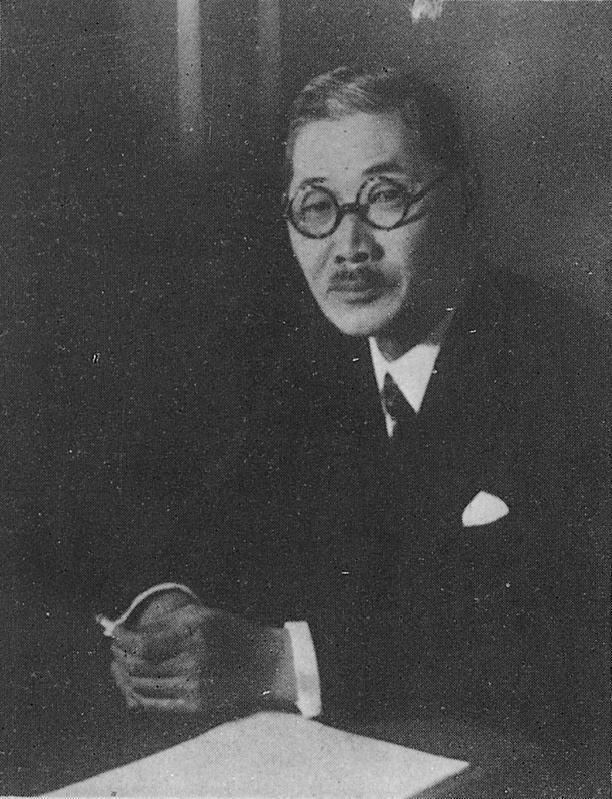Nationality Japan | Name Shigenori Togo | |
 | ||
Born December 10, 1882 ( 1882-12-10 ) Hioki, Kagoshima, Japan Died July 23, 1950(1950-07-23) (aged 67)
Tokyo, Japan Occupation Diplomat, Politician, Cabinet Minister | ||
Shigenori Togo (東郷 茂徳, Togo Shigenori) (Korean: 박무덕, Hanja: 朴茂德, Pak Mudok, 10 December 1882 – 23 July 1950) was Minister of Foreign Affairs for the Empire of Japan at both the start and the end of the Japanese-Allied conflict during World War II. He also served as Minister of Colonial Affairs in 1941, and assumed the same position, renamed the Minister for Greater East Asia, in 1945.
Contents
Biography
Togo was born in Hioki District, Kagoshima, in what is now part of the city of Hioki, Kagoshima. He was a graduate of the Literature Department of Tokyo Imperial University in 1904, and subsequently studied the German language at Meiji University. He entered the Ministry for Foreign Affairs in 1912, after applying for a post five times.
Prewar service
Togo’s first overseas posting was to the Japanese consulate at Mukden, in Manchuria in 1913. In 1916, he was assigned to the Japanese embassy in Bern, Switzerland. In 1919, Togo was sent on a diplomatic mission to Weimar Germany, as diplomatic relations between the two countries were reestablished following the Japanese ratification of the Treaty of Versailles. He returned to Japan in 1921 and was assigned to the Bureau of North American affairs. In 1922, despite the strenuous objections of Togo’s family, he married a German woman, the widow of noted architect George de Lalande who has designed numerous buildings in Japan and its empire, including the Japanese General Government Building in Seoul. The wedding was held in the Imperial Hotel in Tokyo. In 1926, Togo was appointed as secretary to the Japanese embassy in United States, and moved to Washington DC. In returned to Japan in 1929, and after a brief stay in Manchuria, was sent back to Germany. He was the head of the Japanese delegation to the largely unsuccessful World Disarmament Conference held in Geneva in 1932. Togo returned to Japan in 1933 to assume the post of director of the Bureau of North American affairs, but was in a severe automobile accident which left him hospitalized for over a month.
In 1937, Togo was appointed as Japanese ambassador to Germany, serving in Berlin for a year. After Togo was replaced as ambassador to Germany by Hiroshi Oshima, he was reassigned to Moscow as the ambassador to the Soviet Union 1938-1940. During this time, he negotiated a peace settlement following the Battles of Khalkhin Gol between Japan and the Soviet Union, and successfully concluded the Soviet-Japanese Neutrality Pact in April 1941. He was then recalled to Japan by then Foreign Minister Yosuke Matsuoka for reassignment.
Wartime service
Togo was adamantly against war with the United States and the other western powers, which he felt was generally unwinnable, and together with Mamoru Shigemitsu, made unsuccessful last-ditch efforts to arrange for direct face-to-face negotiations between Prime Minister Fumimaro Konoe and US President Franklin Roosevelt in an attempt to stave off the conflict. In October 1941, Togo became Foreign Minister in the Tojo administration. Once war was decided, it was Togo’s signature on the declaration of war, as he disliked pressing the responsibility of the failure of diplomacy on others. With the start of World War II, Togo worked quickly to conclude an alliance between Japan and the Kingdom of Thailand in late 1941.
As part of a more reconciliatory policy towards the western powers, he announced on January 21, 1942 that the Japanese government shall uphold the Geneva Convention even though it did not sign it. On September 1, 1942, resigned his post as Foreign Minister due to his opposition to establish a special ministry for occupied territories within the Japanese government (the new ministry, the Ministry of Greater East Asia was eventually established in November of that same year). Although appointed to the Upper House of the Diet of Japan, throughout most of the war, he lived in retirement.
Upon the formation of the government of Admiral Kantaro Suzuki in April 1945, Togo was asked to return to his former position as Minister of Foreign Affairs. In that position, he was one of the chief proponents for acceptance of the Potsdam Declaration which, he felt, contained the best conditions for peace Japan could hope to be offered. Up until the last, Togo hoped for favorable terms from the Soviet Union. At Togo's suggestion, no official response was made to the Declaration at first, though a censored version was released to the Japanese public, while Togo waited to hear from Moscow. However, Allied leaders interpreted this silence as a rejection of the Declaration, and so bombing was allowed to continue. Togo was one of the Cabinet Ministers who advocated Japanese surrender in the summer of 1945. Several days after the atomic bombings of Hiroshima and Nagasaki, the Japanese government agreed to unconditional surrender.
Following the end of World War II, Togo retired to his summer home in Karuizawa, Nagano. However, he was soon arrested by the Supreme Commander of the Allied Powers on war crime charges, along with all former members of the Japanese government, and was held at Sugamo Prison. During the International Military Tribunal for the Far East, Haruhiko Nishi agreed to act as his defense attorney. On 4 November 1948, Togo was sentenced to 20 years imprisonment. Togo, who suffered from atherosclerosis, died of cholecystitis while in prison.
A volume of his memoirs was published posthumously under the title The Cause of Japan, which was edited by his former defense counsel Ben Bruce Blakeney.
Family
The Japanese diplomat and scholar on international relations, Kazuhiko Togo, is his grandson.
